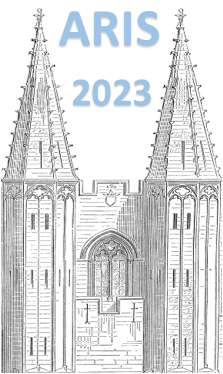Orateur
Description
The term ‘island of inversion’ is used to refer to a region of the nuclear landscape in which deformed intruder configurations dominate nuclear ground states over the spherical configurations naively expected from the shell model. Theoretical models of the inversion mechanism can be tested through detailed studies of the nuclear structure of transitional nuclei, in which the normal and intruder configurations compete. One such transition occurs along the N = 20 isotones, where neutron-rich $^{32}$Mg is known to have a deformed ground-state configuration, while $^{34}$Si displays a normal ground state configuration. Previous studies of the intermediate N = 20 isotone $^{33}$Al have yielded conflicting results regarding its structure. In the present work, $^{33}$Al was studied through the $\beta$-decay of $^{33}$Mg to clarify these discrepancies. A low-energy radioactive beam of $^{33}$Mg was delivered at a rate of 10e3 ions/s by the Isotope Separator and Accelerator (ISAC-I) facility at TRIUMF. Data were collected with the GRIFFIN high-purity germanium $\gamma$-ray spectrometer coupled with the SCEPTAR plastic scintillator array and the ZDS (zero degree) $\beta$ particle detectors. The majority of the data were collected in a cycled mode (with a period of 2 s beam on, 1.5 s beam off) to provide sensitivity to all of the $^{33}$Mg, $^{33}$Al, $^{32}$Al ($\beta$-n daughter) and $^{33}$Si half-lives. The high efficiency of the GRIFFIN detector provided new $\gamma$-$\gamma$ coincidences to elucidate the excited state structure of $^{33}$Al, and the capability of GRIFFIN to detect weak transitions has provided more complete $\beta$-decay branching ratios for the $^{33}$Mg--$^{33}$Al--$^{33}$Si decay chain. Results following the $\beta$-decay of neutron-rich $^{33}$Mg are presented. Approximately 10$^{8}$ $\gamma$-$\gamma$ coincidences were used to build level schemes for $^{33}$Al and $^{32}$Al. The $\gamma$-gated time spectra were fit to calculate half-lives of $^{33}$Mg, $^{32, 33}$Al and $^{33}$Si, $\beta$ counts were used to calculate $\beta$-feeding to the levels of the scheme of $^{33}$Al, including the ground state. Clarification of $^{33}$Al level scheme, and expansion of $^{32}$Al are presented.

